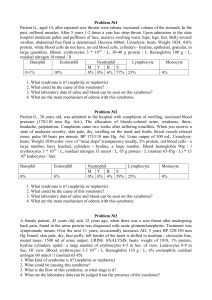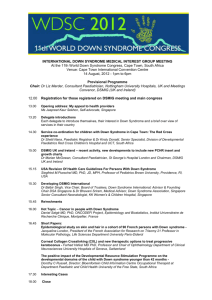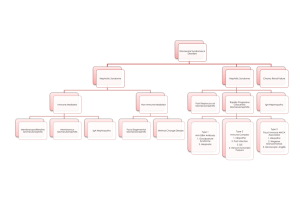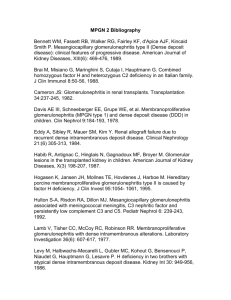Module 1. Pediatrics. Course VI Medical faculty
advertisement
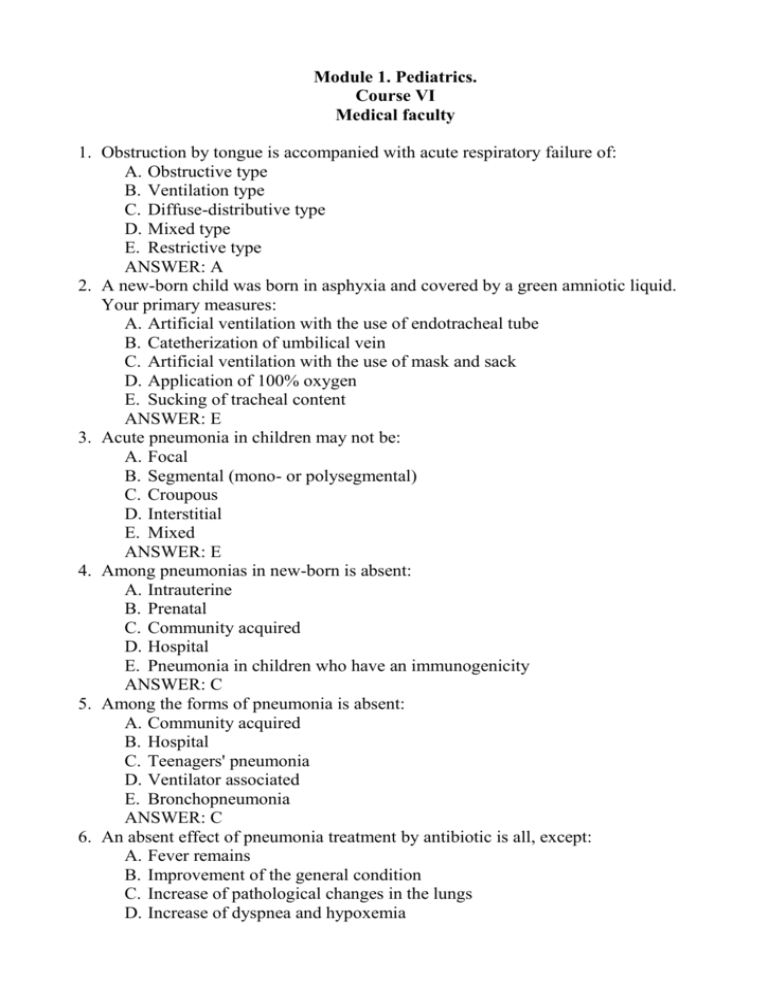
Module 1. Pediatrics. Course VI Medical faculty 1. Obstruction by tongue is accompanied with acute respiratory failure of: A. Obstructive type B. Ventilation type C. Diffuse-distributive type D. Mixed type E. Restrictive type ANSWER: A 2. A new-born child was born in asphyxia and covered by a green amniotic liquid. Your primary measures: A. Artificial ventilation with the use of endotracheal tube B. Catetherization of umbilical vein C. Artificial ventilation with the use of mask and sack D. Application of 100% oxygen E. Sucking of tracheal content ANSWER: E 3. Acute pneumonia in children may not be: A. Focal B. Segmental (mono- or polysegmental) C. Croupous D. Interstitial E. Mixed ANSWER: E 4. Among pneumonias in new-born is absent: A. Intrauterine B. Prenatal C. Community acquired D. Hospital E. Pneumonia in children who have an immunogenicity ANSWER: C 5. Among the forms of pneumonia is absent: A. Community acquired B. Hospital C. Teenagers' pneumonia D. Ventilator associated E. Bronchopneumonia ANSWER: C 6. An absent effect of pneumonia treatment by antibiotic is all, except: A. Fever remains B. Improvement of the general condition C. Increase of pathological changes in the lungs D. Increase of dyspnea and hypoxemia E. Decrease of dyspnea and hypoxemia ANSWER: B 7. At mild pneumonia antibacterial therapy lasts: A. 5 - 7 days B. 3 - 5 days C. 7 - 10 days D. 10 - 14 days E. 15 - 18 days ANSWER: C 8. Choose criteria of respiratory deficiency: A. Everything enumerated is right B. Cyanosis of the skin C. Redness of the skin D. Short breath E. Pain in abdomen ANSWER: B 9. Medicine of choice to treat typical community acquired pneumonias is: A. Aminopenicillins B. Carbapenems C. Fluorquinolones D. Antibiotics of other groups E. Tetracycline’s ANSWER: A 10.Mostly destructive pneumonia is caused by: A. Pneumococci B. Staphylococci C. Proteus D. Klebsiella E. Streptococci ANSWER: B 11.More often the reason of bronchial asthma is the: A. Dust B. Drugs C. Food D. Bacteria E. Viruses ANSWER: A 12.The duration of acute bronchitis is: A. 5 – 7 days B. 7 – 14 days C. 10 – 20 days D. 14 – 24 days E. 2-3 days ANSWER: A 13.Drugs, which have no mucolitic effect: A. Acetylcustein B. Bromhexin C. Ambroxol D. Mucaltin E. Claritin ANSWER: E 14.Most important in diagnostics of obstructive bronchitis is: A. Auscultation B. X-ray examination C. Laboratory investigations D. Bronchoscopy E. Anamnesis ANSWER: D 15.The auscultation date during bronchitis is: A. Puerile breathing B. Decrease breathing C. Rough breathing D. Moist local rales E. Crepitus rales ANSWER: C 16.Acute bronchiolitis is accompanied with acute respiratory failure of: A. Ventilation type B. Diffuse-distributive type C. Mixed type D. Restrictive type E. Obstructive type ANSWER: E 17.All factors can lead to bronchitis, except: A. Cooling B. Poor feeding C. Allergies D. Genetically predilection E. Bad ecology ANSWER: B 18.Asthmatic status is the attack of asthma during more than: A. 6 hours B. 24 hours C. 2 hours D. 5 hours E. 12 hours ANSWER: A 19.During the decreasing of signs of acute period of obstructive bronchitis the first of all is disappearing: A. Rales B. Cough C. Rough breathing D. Wheezing E. Inflammation syndrome ANSWER: A 20.During the treatment of asthma it is necessary to need such inhalator: A. Salbutamol B. Euphyllini C. Inhalipt D. Cameton E. Prednisolone ANSWER: A 21.At bronchography in cystic fibrosis patients there is: A. Presence of drop-shaped bronchiectasis B. Bronchial abnormalities C. Decrease in the number of small branches D. Bronchi 3-6-th calibre are in the form of beads E. All transferred ANSWER: E 22.At mild course of chronic lung disease in children there is involvement of: A. 1-2 segments B. 2-3 segments C. 4-5 segments D. 5-6 segments E. 7-8 segments ANSWER: A 23.Dyspnea at chronic lung disease in children is often: A. Expiratory B. Inspiratory C. Mixed D. Associated only with physical activity E. Associated with emotions ANSWER: C 24.Final diagnose of pulmonary hypoplasia is based on: A. Bronchography B. Bronchoscopy C. X-ray examination D. US observation of lungs E. CTG ANSWER: A 25.General blood analysis at idiopathic pulmonary hemosiderosis reveals: A. Anemia B. Aniso- and poicylocytosis C. Reticulocytosis D. Low colour index E. All transferred ANSWER: E 26.Give characteristic of skin in cystic fibrosis patients. A. Pale B. Pale-gray C. Wet D. Atrophic E. Greasy ANSWER: B 27.Hamman-Rich syndrome is characterized by: A. Rapidly progressive diffuse pulmonary fibrosis B. Respiratory failure C. Pulmonary hypertension D. Cor pulmonale E. All transferred ANSWER: E 28.Name one of the defects at Kartagener syndrome. A. Atonia of esophagus B. Cogenital achalasia of esophagus C. Sinus viscerus inversus D. Congenital heart disease E. Lung hypoplasia ANSWER: C 29.The intestinal obstruction in cystic fibrosis patients on the 3-4-th day of life is associated with: A. Pneumonia B. Perforation of the intestine C. Meconium peritonitis D. Pancreas insufficiency E. Collapse ANSWER: A 30.The main diagnostic value at cystic adenomatoid malformation have next investigations: A. X-ray and CT B. Bronchoscopy and X-ray C. X-ray and bronchography D. CT and bronchography E. Bronchoscopy and bronchography ANSWER: D 31.Fibroelastosis as a result of: A. Viral carditis B. Bacterial carditis C. Fungi carditis D. Early congenital carditis E. Late congenital carditis ANSWER: D 32.Mitral facies is observed in: A. Severe mitral stenosis with low cardiac output B. Severe mitral stenosis with high cardiac output C. Moderate and severe mitral stenosis with low cardiac output D. Moderate and severe mitral stenosis with low cardiac output E. In all cases of mitral stenosis ANSWER: A 33.Morphological changes at rheumatism are mainly in: A. Lymph B. Connective tissue C. Blood D. Muscles E. Fat tissue ANSWER: B 34.Name changes on skin and mucous membranes at Kawasaki disease. A. A rash, sometimes in the groin region B. Red, swollen and cracked lips, bright red, swollen tongue C. Red eyes D. Red rash on palms of hands and soles of feet E. All transferred ANSWER: E 35.Name specific findings at physical examination of patients with cardiomyopathy. A. No specific physical examination findings are consistent B. Prominent apical beat C. Apical displacement D. Heart murmurs E. All transferred ANSWER: A 36.Pinkish-purple patches on cheeks are characteristic for: A. Mitral insufficiency B. Mitral stenosis C. Aortic insufficiency D. Aortic stenosis E. Tricuspid insufficiency ANSWER: B 37.Quite often rheumatism durates with: A. Only arthritis B. Only myocarditis C. Pancarditis D. With arthritis and chorea E. Only pericarditis ANSWER: C 38.Rheumatic endocarditis is characterized by: A. Rough systolic murmur on the apex B. Accent of іі tone above the aorta C. Soft systolic murmur on the apex D. Systolic murmur above the pulmonary artery E. Soft systolic murmur on the aorta ANSWER: A 39.Rheumatic pancarditis is characterized by: A. The decrease of Arterial pressure B. Strengthening of cardiac tones C. The increase of Arterial pressure D. Decreasment of heart's sizes E. Considerable cardiomegalia ANSWER: E 40.Rheumatism is more frequent due to: A. Flu B. Sinusitis C. Scarlet fever D. Measles E. Rhinitis ANSWER: C 41.What is the best method for diagnostic of arrhythmias? A. ECG B. Holter-monitoring C. EchoCG D. Heart catheterization E. All transferred ANSWER: B 42.Irritation of nervus vagus is effective at: A. Ventricular form of paroxysmal tachycardia B. Supraventricular form of paroxysmal tachycardia C. All forms of paroxysmal tachycardia D. Has mild effectivity E. Supporting of medicines ANSWER: B 43.The first medicine at treatment of ventricular paroxysmal tachycardia is: A. Cordaroni B. Novocainomidi C. Corgluconi D. Lidocaini E. Seduxeni ANSWER: D 44.Pallor skin, cold extremities, increase of body temperature and systolic arterial pressure and loud heart tones are observed at: A. Symphatotonic collapse B. Paralytic collapse C. Vagotonic collapse D. Post hemorragic collapse E. At all types of collapse ANSWER: A 45.Position of patient at syncope must be: A. Horizontal with the low position of feet B. Horizontal with high position of feet C. Half sitting with the inclined head to the right D. Half sitting with the inclined head to the left E. Raised with the low position of feet ANSWER: B 46.The best medicines at paralytic collapse are: A. Droperidoli,aminasini B. Eyphyllini, salbutamoli C. Cordiamini, caffeini D. Reopolyglucini, polyglucini E. Adrenalini, mezatoni ANSWER: E 47.The clinical signs of syncope are: A. Darkening in eyes, noise in ears B. Weakness, dizziness C. Nausea, appeals on vomiting D. All of these E. Nothing of these ANSWER: D 48.Vasodilatation at treatment of heart failure is achieved by: A. Nitroprussidi sodium B. Phentalamini C. Captoprilli D. Euphyllini E. All transferred ANSWER: E 49.Ventricular tachycardia is indeed the most dangerous of the cardiac arrhythmias with a real risk of: A. Infarction B. Sudden cardiac death C. Myocardiosclerosis D. Heart failure E. All transferred ANSWER: B 50.What is applied at presence of high-waving heart fibrillation? A. Adrenalini B. Lidocaini C. Atropini D. Hydrocarbonati of sodium E. All of these ANSWER: B 51.At which systemic connective tissue disease the clinic of myocarditis is the most prominent? A. SLE B. SSD C. JRA D. Polyarteritis nodosa E. Dermatomyositis ANSWER: A 52.Basic vessels’ damaging factor at polyarteritis nodosa is: A. Viruses B. Bacterial toxins C. Circulating immune complexes D. Cool allergens E. Chemical toxins ANSWER: C 53.Basis of the RA pathogenesis is: A. Osteomalacia B. Autoimmune processes in connective tissue C. Damage of the mineral processes in bones D. Acute infectious inflammation of joints E. Systemic dysplasia of connective tissue ANSWER: B 54.Bedsores and necroses of soft tissues at Dermatomyositis are rare in the area of: A. Buttocks B. Scapulas C. Sacrum D. Elbows E. Small hand joints ANSWER: A 55.Body temperature at polyarteritis nodosa decreased, as a rule, after setting of: A. Antibiotics B. Glucocorticoids C. NSAIDs D. Anti convulsive preparations E. Immunedepressors ANSWER: B 56.Calcinosis at Dermatomyositis can develop mainly in: A. Kidneys B. Cardiac muscle C. Lungs D. Muscles E. Joints ANSWER: D 57.CREST-syndrome is: A. Systemic scleroderma in combination with rheumathoid arthritis B. Systemic scleroderma in combination with glomerulonephritis C. Systemic scleroderma in combination with osteoporosis D. Systemic scleroderma in combination with rheumatism E. Systemic scleroderma in combination with hemorrhagic vasculitis ANSWER: A 58.Damage of eyes at JRA more frequent looks as: A. Conjunctivitis B. Rethynopathy C. Retina's degeneration D. Irydocyclitis E. Cataract ANSWER: D 59.Damage of heart at acute and subacute duration of dermatomyositis has signs of: A. Myocardial dystrophy B. Myocardiosclerosis C. Endocarditis D. Myocarditis E. Pericarditis ANSWER: D 60.Dermatomyositis is more frequent in: A. Girls B. Boys C. Newborns D. Preschoolers E. Teenagers ANSWER: A 61.Appetite in duodenal ulcer: A. Reduced B. Increased C. Not changed D. Distortion of taste E. Available ANSWER: B 62.Assign a drug with gastroesophageal reflux to improve gastric motility: A. Almagel B. Hastronorm C. Motilium D. Kvamatel E. No-spa ANSWER: C 63.Assign the correct secretory disorders in reflux esophagitis: A. Motilium B. No-spa C. Hastroform D. Kvamatel E. Smecta ANSWER: D 64.At low gastric acidity is often observed: A. Tendency to constipation B. Unstable stool C. Burp "sour" D. "hunger pains" E. Vomiting ANSWER: B 65.Belching rotten characteristic of patients with gastritis with acid- function: A. Increased B. Normal C. Reduced D. Preserved E. All wrong ANSWER: C 66.Clinical symptoms of gastro-esophageal reflux A. Headache, dysphagia B. Chest pain, heartburn, nausea C. Pain in the right upper quadrant D. Nausea, pain in the left upper quadrant, diarrhea E. In the left upper quadrant pain, diarrhea ANSWER: B 67.Complications of peptic ulcer do not include: A. Intestinal obstruction B. Penetration C. Perforation D. Stenosis of the pylorus E. Peryvistserytis ANSWER: A 68.Famotidine refers to a group: A. Antacids B. H2- histamine blockers C. Hydrogen pump inhibitors D. Reparants E. Cytoprotectors ANSWER: B 69.For endoscopic characteristics in children occurs less often chronic gastroduodenitis: A. Surface B. Hemorrhagic C. Atrophic D. Mixed E. Erosive ANSWER: C 70.In gastric ulcer using the following drugs: A. Analgin B. De-nol C. essentiale D. Prednisone E. Aspirin ANSWER: B 71.What group of drugs is solcoseril? A. Antacids B. Prokinetic C. H2 histamine blockers D. Reparant E. Cytoprotectors ANSWER: D 72.What is achalasia? A. Changes cardia under which hampered its permeability B. Failure gastro-esophageal sphincter C. Narrowing of the pylorus D. Failure pylorus E. Expand all esophagus ANSWER: A 73.What medication is prescribed for treatment of chalasia? A. Papaverine B. Analginum C. Motilium D. Aspirin E. Penicillin ANSWER: C 74.What method of diagnosis is carried out during endoscopic examination? A. Urease test on biopsies B. Respiratory urease test C. serological diagnosis D. Microbiological examination of biopsy E. All right ANSWER: A 75.What methods of examination used to diagnose in chalasia A. Ultrasound of the abdomen B. Contrast radiography of the esophagus C. CT D. nuclear magnetic resonance E. R-graphia ANSWER: B 76.What neutralizes ammonia in gastric juice? A. Pepsin B. Hydrochloric acid C. Bicarbonate D. Mucus E. Bile ANSWER: B 77.Which syndrome is the most constant at chronic gastroduodenitis in children? A. Pain B. Dyspeptic C. Intoxication D. Epithelial E. Hemosideric ANSWER: A 78.Who is the main method for diagnosis of gastroesophageal reflux disease: A. EFGDS B. Ultrasound C. Ph-metry of esophagus D. Ro- graphy of esophagus E. Duodenal intubation. ANSWER: C 79.With increased gastric acidity is not typical: A. Constipation B. Diarrhea C. Epigastric pain D. Belching E. Nausea ANSWER: B 80.What are the contraindications for the sigmoidoscopy? A. Prolapse of the rectum B. Bleeding from the intestines C. Mucus in the feces D. Bleeding from feces E. No contraindications ANSWER: E 81.Edema syndrome at hereditary nephropathy is often seen as: A. Swollen face B. Swollen legs C. Anasarca D. Swollen skin E. Swollen lumbar area ANSWER: D 82.Hereditary nephritis (Alport syndrome) is suspected. What is characteristic for this disease? A. Hematuria B. Proteinuria C. Crystaluria D. Deafness E. Leucocyturia ANSWER: D 83.Hereditary nephritis is typically ends with: A. Recovering B. Formation of pyelonephrosis C. Chronic renal failure D. Development of urolithiasis E. Acute renal failure ANSWER: C 84.Severe edema syndrome is most characteristic for: A. Nephrotic syndrome B. Nephritic syndrome C. Mixed form of chronic glomerulonephritis D. Hematuric form E. Isolated urinary syndrome ANSWER: A 85.Significant proteinuria is the symptom of: A. Cystitis B. Urethritis C. Vulvovaginitis D. Glomerulonephritis E. Pyelopephritis ANSWER: D 86.Syndrome of urine changes doesn’t includes: A. Painful urination B. Proteinuria C. Hematuria D. Casturia E. Leucocyturia ANSWER: A 87.What from the resulted symptoms is not characteristic for glomerulonephritis? A. Pain in back B. Pain during the act of urination C. Hypertension D. Edema E. Oliguria ANSWER: B 88.What from the resulted symptoms is the criterion of acute glomerulonephritis, nephritic variant? A. Hematuria B. Leucocyturia C. Bacteruria D. Anasarca E. Proteinuria more than 3g per day ANSWER: A 89.What from these signs do not present at pyelonephritis? A. Leucocytosis B. Leucocyturia C. Little proteinuria D. Hematuria E. Bacteriuria ANSWER: D 90.What investigation demonstrate the concentration function of kidneys? A. General analysis of urine B. Analysis of urine by Nechiporenko C. Analysis of urine by Zimnitskiy D. Ultrasound investigation of kidneys E. Biochemical analysis of blood ANSWER: C 91.What is the main feature of urine infection in children? A. Leucocyturia B. Bacteriuria C. Erythrocyturia D. Cylindruria E. All transferred ANSWER: B 92.What symptom is the most important for diagnostic of hematuric form of hereditary nephritis? A. Leucocyturia B. Edema C. Erytrocyturia D. Cylindruria E. Proteinuria ANSWER: C 93.Bright red colour of urine can be the symptom of: A. Virus hepatitis B. Hemolysis incase of poisoning C. Renal tumor D. Glomerulonephritis E. Pyelopephritis ANSWER: C 94.Dose of prednisolone during the nephrotic variant of glomerulonephritis is: A. 0,5 – 0,75 mg/kg/day B. 0,8 – 1 mg/kg/day C. 1,5 – 2,5 mg/kg/day D. 2,5 – 3 mg/kg/day E. 4 – 4,5 mg/kg/day ANSWER: C 95.During hormone depending nephrotic form of chronic glomerulonephritis it is necessary to prescribe with prednisolone: A. Nonsteroid antiinflamation drugs B. Preparates of aminohinolin group C. Cytostatics D. Heparin E. Antibiotics ANSWER: C 96.Indicate which of the following below is a feature of acute urinary infections in infants and children during the first months of life? A. High fever B. Dyspepsia C. Severe intoxication D. Dizuric signs E. All transferred ANSWER: A 97.Rickets like changes among hereditary nephropathy are often found as: A. Cystic kidneys B. Phosphate-diabetes C. Renal without hereditary deafness D. Renal with hereditary deafness E. Renal amyloidosis ANSWER: B 98.The average age dose of lasix is: A. 1-2 mg/kg/day B. 4-5 mg/kg/day C. 10 mg/kg/day D. 0,5-1 mg/kg/day E. 0,5mg/kg/day ANSWER: A 99.Urine analysis determines such data, except: A. Colour of urine B. Specific gravity C. Level of protein, glucose, sugar, ketone bodies D. Microscopy of sediment: leukocytes, erythrocytes, cylinders, endotelial cells E. Daily urine volume ANSWER: E 100. What from these products are eliminated in a diet 7? A. Rice B. Porridge C. Vegetable puree D. Egg E. Meat ANSWER: E



